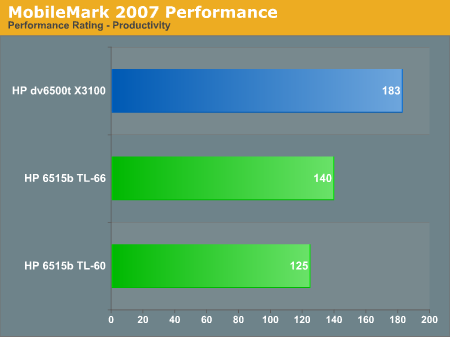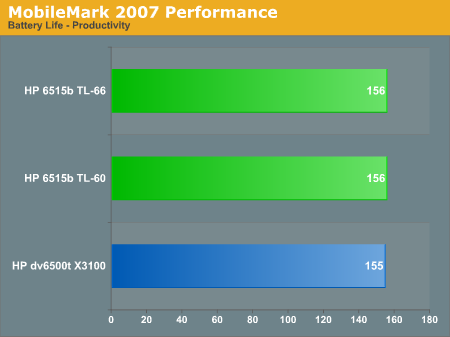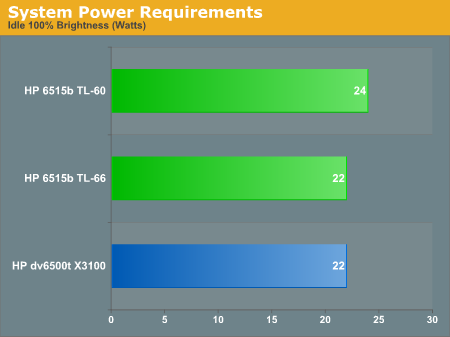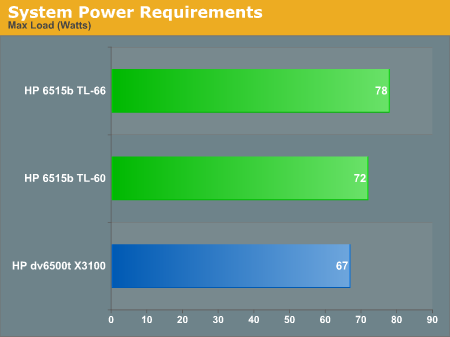Mobile Platform Wars: AMD vs. Intel
by Jarred Walton on October 5, 2007 9:10 AM EST
Battery Life and Power Requirements
The final area that we need to at least look at briefly is the power requirements and battery life offered up by the two different platforms. Again, it is very important to remember that the HP dv6500t has a larger screen, which may require a couple more watts than the screen on the 6515b. That could translate into anywhere from 0 to 30 minutes of battery life under the test conditions. The 6515b also has a 55WHr battery compared to a 47WHr battery, so if power requirements are equal the 6515b should end up lasting longer. We do have MobileMark 2007 now, which we will be using for future battery performance evaluations. We ran the DVD Playback and Productivity portions of the benchmark.



As we already discussed, perhaps the best news is that the TL-66 either matches or improves on the battery life offered by the TL-60 while also increasing performance. Unfortunately, it does this at the penalty of increasing CPU costs by about $200 - roughly twice the price of the TL-60. In contrast, the battery life of the dv6500t is slightly lower, but considering the difference in LCDs and batteries it seems to be the more frugal laptop in terms of power use. Since we aren't able to do a true apples-to-apples comparison, we can't say for sure, but the AMD system only offers at best 6% more battery time with its 17% larger battery. Looking at the power requirement numbers will make this a bit clearer.


Idle power draw for the dv6500t and the 6515b with a TL-66 are the same at 22W, with the TL-60 using slightly more power. Once we crank up the load on the system, however, both AMD configurations end up using 5W and 11W (TL-60 and TL-66, respectively) more than the Intel laptop. The "max load" results shown above involve running Folding@Home SMP at the same time as we run a game in order to fully stress all CPU cores as well as the GPU.
To further isolate the source of the power use, we ran the same tests individually to stress just the CPU along with the GPU and one CPU core. We also included minimum and maximum power draw by decreasing/increasing the display brightness. These results are summarized below.
The most interesting aspect of this table is to look at the difference between idle power draw and 100% CPU load, as that allows us to remove the LCD power requirements from the equation. While we can't say which CPU is better at reducing power requirements at idle (due to the aforementioned platform differences), we can clearly conclude that the Intel CPU requires less power to do more work at load. The power delta is 35 W for the T7300, 39 W for the TL-60, and 48 W for the TL-66. AMD does well at reducing their idle power requirements, but when the CPU is actually working Intel leads by a relatively large margin.
The final area that we need to at least look at briefly is the power requirements and battery life offered up by the two different platforms. Again, it is very important to remember that the HP dv6500t has a larger screen, which may require a couple more watts than the screen on the 6515b. That could translate into anywhere from 0 to 30 minutes of battery life under the test conditions. The 6515b also has a 55WHr battery compared to a 47WHr battery, so if power requirements are equal the 6515b should end up lasting longer. We do have MobileMark 2007 now, which we will be using for future battery performance evaluations. We ran the DVD Playback and Productivity portions of the benchmark.



As we already discussed, perhaps the best news is that the TL-66 either matches or improves on the battery life offered by the TL-60 while also increasing performance. Unfortunately, it does this at the penalty of increasing CPU costs by about $200 - roughly twice the price of the TL-60. In contrast, the battery life of the dv6500t is slightly lower, but considering the difference in LCDs and batteries it seems to be the more frugal laptop in terms of power use. Since we aren't able to do a true apples-to-apples comparison, we can't say for sure, but the AMD system only offers at best 6% more battery time with its 17% larger battery. Looking at the power requirement numbers will make this a bit clearer.


Idle power draw for the dv6500t and the 6515b with a TL-66 are the same at 22W, with the TL-60 using slightly more power. Once we crank up the load on the system, however, both AMD configurations end up using 5W and 11W (TL-60 and TL-66, respectively) more than the Intel laptop. The "max load" results shown above involve running Folding@Home SMP at the same time as we run a game in order to fully stress all CPU cores as well as the GPU.
To further isolate the source of the power use, we ran the same tests individually to stress just the CPU along with the GPU and one CPU core. We also included minimum and maximum power draw by decreasing/increasing the display brightness. These results are summarized below.
| System Power Draw (at outlet with battery removed) | ||||
| Idle | 100% CPU | Gaming | Max Load | |
| HP 6515b TL-60 | 18-24 | 57-63 | 67 | 72 |
| HP 6515b TL-66 | 16-22 | 64-70 | 71 | 78 |
| HP dv6500t | 16-22 | 51-57 | 62 | 67 |
The most interesting aspect of this table is to look at the difference between idle power draw and 100% CPU load, as that allows us to remove the LCD power requirements from the equation. While we can't say which CPU is better at reducing power requirements at idle (due to the aforementioned platform differences), we can clearly conclude that the Intel CPU requires less power to do more work at load. The power delta is 35 W for the T7300, 39 W for the TL-60, and 48 W for the TL-66. AMD does well at reducing their idle power requirements, but when the CPU is actually working Intel leads by a relatively large margin.










33 Comments
View All Comments
tomycs - Sunday, December 9, 2007 - link
Since we talk about bargains i guess a comparison between the previous generation mid-range (Geforce 7600, ATI X1600) and the entry level graphic chips (Geforce 8400, AMD/ATI HD2300) would have been nice.I find myself choosing between 2 HP's almost equal specs (almost no differences between AMDX2 TL60 and Intel T5500) but one with ATI X1600 and the other with the 8400GS. I'm almost sure i will takle the X1600 because of build quality and screen, but i would have liked some numbers regarding 3D performance.
mobileuser2007 - Wednesday, October 10, 2007 - link
Nice summary Jarred.I was a little surprised to not see anything about video quality. I, for one, don't do any gaming on my notebook but I do watch DVD movies while traveling. It seems the only way AT measures the success of "graphics" is how well they play games. Any thoughts on comparing systems on other visual aspects?
JarredWalton - Wednesday, October 10, 2007 - link
I guess the real problem is that I think most laptop LCDs suck, which means that even if the video card does an excellent job at decoding DVDs or whatever, the display quality makes this a moot point. I didn't think the 6515b was any better or worse than the dv6500t (or any other notebook, really) when it comes to DVD playback. Of course, you can always just get a different DVD decoder application that can make a big difference. DVD decoding is now at the point where the CPU can do all the work and still only put a moderate load on a CPU, even with higher complexity decoding algorithms that improve image quality.Maybe I didn't pay enough attention, though, so I'll see if I can notice any difference with additional testing.
magao - Tuesday, October 9, 2007 - link
Thank you very much for this article.I've been looking for a new laptop for the several months, and have almost settled on one of the 6515b, 6510b (if I can find one in Australia) or (most likely) the 6710b.
I've been searching for months trying to find comparisons of the laptops with anything near the configuration I'm looking at (T7100/GMA X3100, or Turion X2/X1250). The 6515b is pretty much out of contention though since to get an X2 you have to go above the price of the T7100 in the 6710b (the cheap 6515b comes with an MK-38).
It's not going to be a desktop replacement, but it needs to be grunty enough for serious work, and needs good enough graphics to play things up to the level of Guild Wars at native resolution (1280x800). I had a work laptop recently with a T5500 and GMA 950, and GW was playable (but not great - 20-30 FPS most of the time), so I have reasonable expectations of the 6710b. Interestingly, my home server (E2140 with G33/GMA 3000 graphics) has worse GW performance than the GMA 950 - my understanding was that GMA 3000 is basically an upgraded GMA 950, but there appear to be significant differences (GW detects the GMA 3000 as DX8 but GMA 950 as DX9, even when both have the 14.31.1 driver).
I'll be *very* interested in the X3100 results you get under XP (with the 14.31.1 drivers).
BTW, one of the reasons I've settled on the HP laptops is their look and feel. They are simple-looking, no-nonsense designs, that aren't going to show marks, the keyboards feel very nice, the screens are good and the sound is quite good for a laptop.
JarredWalton - Tuesday, October 9, 2007 - link
I'll spoil the results a bit and say that under XP, GMA X3100 appears to best X1250 across the board. Shockingly (pardon the pun), it even runs Bioshock - okay, so it's at about 20FPS at 800x600 (minimum detail), but at least that proves it's mostly drivers under Vista keeping it from running the latest titles. I should have the final article done next week, showing X3100 XP results. Still, for $80 more you can get HD 2300 which remains about 2-3 times as fast, or 8400 GS which is also around 2-3 times as fast.yyrkoon - Sunday, October 7, 2007 - link
I honestly think your time would have been better spent covering some other aspect in the industry. Everyone knows that AMD is in a "rutt' at the moment, and this article really only tells us what we could have guesses on our own. Reasons for an article of this type in my own opinion would be; ground breaking news, or at the very elast a much shorter article just covering the import stuff such as AMDs mobile graphics superiority.There are lots of people out there, with myself included that would like to see you guys do an article on something like SAS IN DEPTH, or SATA Port Multipliers, with benchmarks, implementation, etc.
Also, just going from past experience of reading your articles, I cannot help but wonder why you guys do not have any how-to's such as 'how-to overclock an Intel core 2 CPU . . ', or 'how-to build a cheap storage solution with SAS/HPM technology . . ' , etc. I honestly think filling content with things such as the above mentioned how-to's, would be far more benificial to your readers, than the obvious re-iteration of things we already know.
zsdersw - Sunday, October 7, 2007 - link
Oh? So that's the only thing that's important? It's dubious that you'd pick one of the few bright spots in the article for AMD and tout it as "the important stuff".
yyrkoon - Sunday, October 7, 2007 - link
How would it be dubious that I do not care to hear about the same thing I have been hearing about for the last several months ?zsdersw - Sunday, October 7, 2007 - link
What you do and do not care about is not what's dubious. What's dubious is that the only thing you supposedly regard as "the important stuff" just happens to be the one area of mobile platforms where AMD generally fares better than Intel (mobile graphics chipsets).yyrkoon - Monday, October 8, 2007 - link
Look guy, if you're going to call me an AMD Nazi, fanboi, or whatever, why dont you just come out and say so, instead of making stupid comments that MAY imply *something*. You would be wrong by the way.